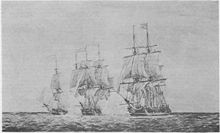Capture of USS Hancock
| Capture of USS Hancock | |||||||
|---|---|---|---|---|---|---|---|
| Part of the American Revolutionary War | |||||||
 Sir George Collier | |||||||
| |||||||
| Belligerents | |||||||
|
|
| ||||||
| Commanders and leaders | |||||||
|
Hector McNeill |
Patrick Fotheringham John Brisbane Michael Hyndman | ||||||
| Strength | |||||||
|
2 Frigates 1 Prize (former HMS Fox), 379 men |
2 Frigates 1 Brig | ||||||
| Casualties and losses | |||||||
|
1 frigate captured, HMS Fox recaptured | Unknown | ||||||
The American frigate USS Hancock was captured by the British Royal Navy in a 1777 naval battle during the American Revolutionary War. The two highest ranking naval officers of the war battled each other off the coast of Nova Scotia. HMS Rainbow (44 guns), under the command of British Admiral George Collier, captured USS Hancock (34 guns), under the command of Captain John Manley.
Background
[edit]During the American Revolutionary War, Americans regularly attacked Nova Scotia by land and sea. American privateers devastated the maritime economy by raiding many of the coastal communities,[1] such as the numerous raids on Liverpool and on Annapolis Royal.[2]
On 7 June USS Hancock and USS Boston engaged the Royal Navy's 28-gun frigate Fox, which tried to outsail her American enemies. Hancock gave chase and soon overhauled Fox, which lost her mainmast and suffered other severe damage in the ensuing duel. About an hour later, Boston joined the battle and compelled Fox to strike her colors.[3]

Hancock spent the next few days repairing the prize and then resumed cruising along the coast of New England. East of Cape Sable, Nova Scotia she took a British coal sloop, which she towed until the next morning when the approach of a British squadron prompted Manley to set the coal sloop ablaze and leave her adrift.[3]
Battle
[edit]
On 8 July, Manley was in Hancock accompanied by Boston and Fox when they arrived at the mouth of Halifax Harbour. Collins was in HMS Rainbow (44 guns) accompanied by the frigate HMS Flora (32 guns) and the brig HMS Victor (18 guns) and they chased the American vessels. The American vessels scattered.
Boston, under command of Captain McNeil, easily escaped. When McNeil returned to Boston he was court-martialled for abandoning Manley and dismissed from the Navy. Flora recaptured Fox after a hot action and brought the vessel into Halifax.
Rainbow and Victor gave chase to Hancock. Early in the morning 9 July 1777 the British were within striking distance of Hancock. Rainbow began to score with her bow chasers and followed with a series of broadsides. Hancock was thus finally forced to strike her colors after a chase of some 39 hours. She had 239 men of her crew aboard, 50 some being on Fox. She also had Captain Fotheringham of Fox and 40 of his people on board. The rest were on Boston and a couple of fishing vessels.[4] Collins took the American vessels back to Halifax. The British renamed the American vessel Iris. Manley and his crew were imprisoned for months and then released back to Boston.[5][6][7]
Aftermath
[edit]American privateers remained a threat to Nova Scotian ports for the rest of the war. For example, after a failed attempt to raid Chester, Nova Scotia, American privateers struck again in the Raid on Lunenburg in 1782.
See also
[edit]Notes
[edit]- ^ Benjamin Franklin also engaged France in the war, which meant that many of the privateers were also from France.
- ^ Roger Marsters (2004). Bold Privateers: Terror, Plunder and Profit on Canada's Atlantic Coast, p. 87-89
- ^ a b "Admiralty-Office, August 23, 1777". The London Gazette. No. 11798. 19 August 1777. p. 2.
- ^ "No. 11798". The London Gazette. 19 August 1777. pp. 2–3.
- ^ "Massachusetts soldiers and sailors of the revolutionary war. A compilation from the archives". Office of the Secretary of State of Massachusetts. 1896. p. 59. OCLC 1049642859.
- ^ Peabody, John E. (January 1909). "The Naval Career of Captain John Manley of Marblehead". Historical Collections of the Essex Institute. XLV (1).
- ^ "Massachusetts soldiers and sailors of the revolutionary war. A compilation from the archives". Office of the Secretary of State of Massachusetts. 1896. p. 910. OCLC 1049642859.
Further reading
[edit]
- Naval battles of the American Revolutionary War involving Great Britain
- Naval battles of the American Revolutionary War involving the United States
- Privateering in the American Revolutionary War
- Conflicts in 1777
- Maritime history of Canada
- Military history of Nova Scotia
- 1777 in Nova Scotia
- Battles of the American Revolutionary War in Nova Scotia
